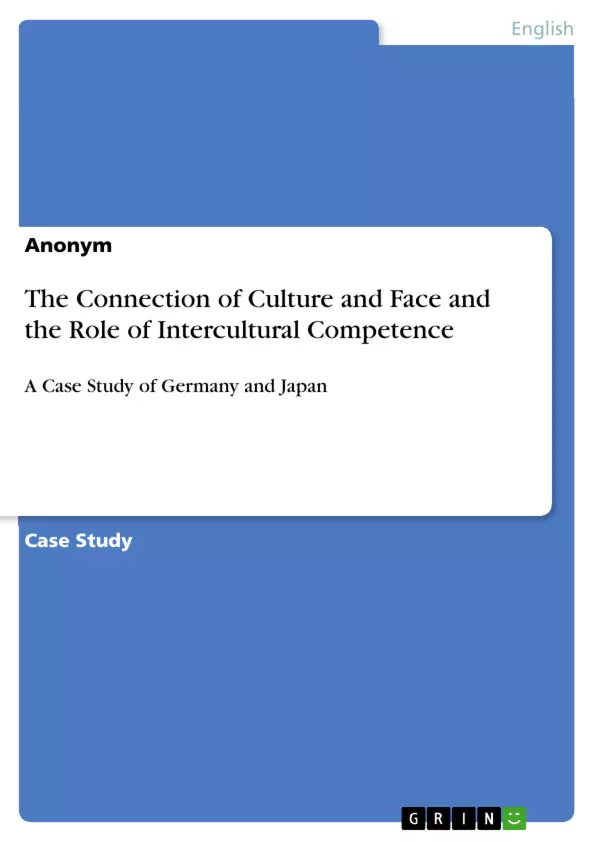Since globalisation leads us to interact more with people from all over the world, it is a logical consequence that we get in touch with an increasing number of people from different cultural backgrounds. Therefore, it is important to be aware that every person has their own concept of face, which refers to one’s values, belief system and behaviour. Thus, it is of critical significance to analyse to what extent the different concepts of face of certain people differ in order to make clear why intercultural misunderstandings might appear.
As culture is one of the most significant factors that have an impact on a person’s concept of face, this term paper is going to deal with the connection of culture and face and will provide a comparison of the German and Japanese face concepts. Following this analysis, a model developed by Claudia Finkbeiner will be introduced to demonstrate how these cultural differences including one’s concept of face might be overcome in order to ensure successful intercultural encounters.
Inhaltsverzeichnis (Table of Contents)
- Introduction
- Culture and Cultural Difference
- Politeness and Face
- The Concept of Face
- Face-Threatening Acts (FTAs) and Politeness Strategies
- Face in the German and Japanese Culture
- Power Distance Index
- Individualism versus Collectivism
- Masculinity versus Femininity
- Uncertainty Avoidance Index
- Long-Term Orientation versus Short-Term Orientation
- Developing Intercultural Competence
- Conclusion
Zielsetzung und Themenschwerpunkte (Objectives and Key Themes)
This term paper explores the connection between culture and the concept of face, using Germany and Japan as case studies. It aims to analyze the differences in face concepts between these two cultures and explain how these differences can lead to intercultural misunderstandings. Ultimately, the paper seeks to demonstrate how these cultural differences, including the concept of face, can be overcome to facilitate successful intercultural interactions.
- The connection between culture and the concept of face.
- A comparative analysis of the German and Japanese concepts of face.
- The role of cultural dimensions in shaping face concepts.
- The potential for intercultural misunderstandings stemming from differences in face concepts.
- Strategies for fostering intercultural competence and overcoming cultural differences.
Zusammenfassung der Kapitel (Chapter Summaries)
- Introduction: This chapter introduces the topic of intercultural communication, emphasizing the significance of understanding cultural differences, particularly in a globalized world. The concept of face is presented as a key factor influencing communication, highlighting the potential for misunderstandings when cultural differences are not considered. The paper outlines its objective to analyze face concepts in Germany and Japan and proposes a model for overcoming intercultural differences.
- Culture and Cultural Difference: This chapter discusses the nature of culture and how cultural differences emerge, laying the groundwork for understanding the variations in face concepts across cultures.
- Politeness and Face: This chapter delves into the concept of face, explaining its link to prestige and exploring face-related actions like saving face and losing face. It also examines the role of politeness strategies in mitigating face-threatening acts.
- Face in the German and Japanese Culture: This chapter compares the concepts of face in Germany and Japan based on Hofstede's five cultural dimensions: power distance, individualism versus collectivism, masculinity versus femininity, uncertainty avoidance, and long-term versus short-term orientation. This analysis highlights the impact of cultural dimensions on face concepts and reveals potential sources of intercultural misunderstandings.
- Developing Intercultural Competence: This chapter introduces a model for fostering intercultural competence, focusing on strategies for overcoming cultural differences and promoting successful intercultural encounters.
Schlüsselwörter (Keywords)
This paper focuses on the concepts of intercultural communication, face, culture, Germany, Japan, cultural dimensions, intercultural competence, and communication strategies.
- Quote paper
- Anonym (Author), 2020, The Connection of Culture and Face and the Role of Intercultural Competence, Munich, GRIN Verlag, https://www.hausarbeiten.de/document/1266587


